- Back
to main book index
- Makers of History
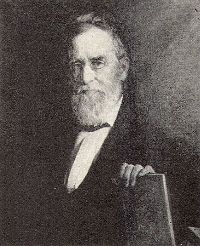
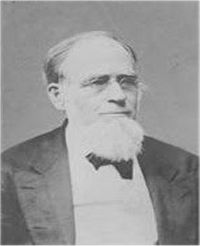
- Jacob Abbott (1803 - 1879) - John S. C. Abbott
(1805 - 1877)
Jacob Abbott (1803-1879) was possibly the most prolific American writer
of juvenile literature of the nineteenth century. He was born in Maine,
the second of seven children. He and each of his four brothers graduated
from Bowdoin College, studied theology, and became teachers or ministers.
Three of the five boys became authors, and with his brother John Steven
Charles (J.S.C.), Jacob authored the famous and widely read "Makers
of History" series of biographies.
It was not until about 1848 that he and his brother embarked on the idea
of doing a series of biography aimed at young people. His target audience
was age "15 to 25", and the Abbott brothers eventually produced
a set of biographies that were critically acclaimed, and widely read. Within
a few years of their publication, the Abbott biographies became standard
reference works of juvenile history, and were available in libraries throughout
America. They were originally published as the 'Illustrated History' series,
but were republished many times during the next sixty years in various collections,
entitled 'Famous Characters of History', 'Famous Queens of History', and
others. They were most recently republished in the early 1900’s as
the 'Makers of History' series.
The Abbotts had a terrific gift for narrative, and their books all read
as if they were high suspense novels. Although the vocabulary level is relatively
high, more appropriate for high school or college than elementary schools,
the writing style is not difficult, and the stories move along at a fast
pace. The Abbott biographies have a delightful combination of action and
adventure, along with truly interesting personality portraits, intriguing
subplots, and fascinating secondary characters which should be appealing
to both young men and young women.
|
William the Conqueror
Even before invading England to claim the throne, William the Conqueror
was recognized throughout Europe as the greatest warrior of his time. His
entire life was a series of battles and rebellions in which he was uniformly
successful. He was often hated but always respected by his subjects, and
his iron-fisted policies were more effective in ruling England than in
managing his own family.
Click here to
read as a webpage
|
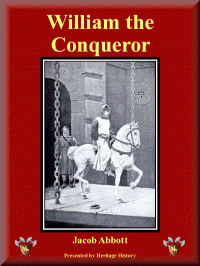 |
|
Alexander the Great
Although Alexander ruled only thirteen years, his conquests are among the
most significant in world history. Abbott's history covers his childhood
influences, his early conquests in Greece, and his major battles in Persia,
including Granicus River, Issus, the Siege of Tyre, and Gaugamela. The
story concludes with the decline and corruption of Alexander's character,
resulting in his early death at age thirty-three.
Click here to
read as a webpage
|
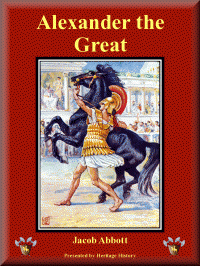 |
|
Cyrus the Great
Cyrus the Great was the founder of the Persian Empire, and the story of
his life gives great insights into the politics of the empires of central
asia in the sixth century B.C. Highlights of Cyrus's history include his
romantic childhood, his conquest of Media with the aid of traitors from
his grandfather's court, the story of Croesus--wealthy king of Lydia, the
sieges of Tyre and Babylon, the restoration of the Jews, and the ill-fated
campaign in Scythia.
Click here to
read as a webpage
|
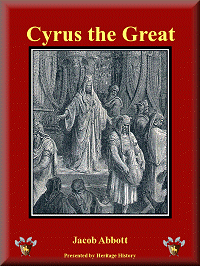 |
|
Darius the Great
The story of Darius began with Cambyses' ascension to the Persian throne
and his subsequent conquest of Egypt. On Cambyses' death, a usurper assumed
the throne. Darius dispatched the usurper and was awarded the throne. He
then embarked on a series of misadventures including a thwarted excursion
to Scythia, crushing a rebellion in Ionia, and two unsuccessful campaigns
to conquer Greece, including the famous battle of Marathon.
Click here to
read as a webpage
|
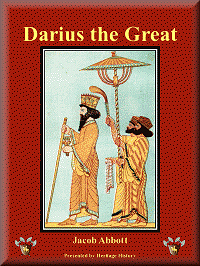 |
|
Xerxes
On the demise of Darius, the Persian throne descended to his son Xerxes.
After putting down a rebellion in Egypt, he formed a plan to invade Greece
with an enormous army drawn from every province of the vast Persian Empire.
The land battles of Thermopylae and Plataea as well as the naval battles
of Artemisium, Salamis, and Mycale are described here, complete with the
complicated but heroic strategems of the Greek hero Themistocles.
Click here to
read as a webpage
|
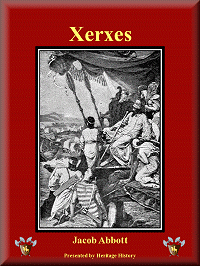 |
|
Pyrrhus
The decades following the death of Alexander the Great involved a long
and complicated series of wars between his generals, which split his empire.
Pyrrhus, a prince of Epirus, was a leading historical character during
this time, and Abbott uses his life to illuminate the entire era. Other
characters including Alexander's villanous mother Olympias and his trusted
advisor Antipater figure prominently in this story. Pyrrhus himself is
a fascinating character, combining great talent and energy with fatal weaknesses.
Click here to
read as a webpage
|
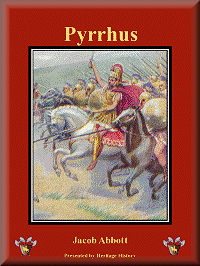 |
|
Romulus
This story of early days of Rome, begins with the legendary flight of Aeneas
from Troy and his adventures before around the Mediterranean before founding
a kingdom in Latium. The story of Romulus, the prince of Latium who founded
the city of Rome does not begin until halfway through the book. From that
point all the most famous legends of the founding of Rome are recounted,
from the strange childhood of Romulus and Remus, to the kidnapping of the
Sabine women, to the mysterious death of Rome's first king.
Click here to
read as a webpage
|
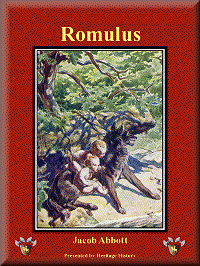 |
|
Hannibal
This account of the life of the famous Carthaginian general who acquired
distinction as a warrior by his desperate contests with the Romans was
written for mature high school students and young adults. Its lively treatment
of the Punic Wars depicts Hannibal's crossing of the Alps with his elephants,
the battles he waged in Italy, and his eventual defeat. Although Hannibal
is the central character, the book begins with a brief overview of the
first Punic War, and ends with the destruction of Carthage following the
third Punic war.
Click here to
read as a webpage
|
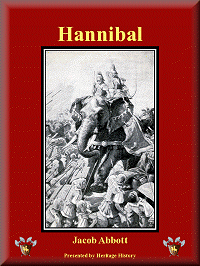 |
|
Julius Caesar
This book recounts the life of Caesar, who remains one of the most controversial
and fascinating characters in world history. He was a man of action with
many battles to his credit, including the Gallic Wars, Pharsalia, and the
Alexandrine War. But even more, he was a mastermind. He laid the groundwork
for the empire with his brilliant reorganization of the legions and his
plan for consolidation of power. He was a master statesman as well as a
general and won over as many rivals with diplomacy as he did on the battlefield.
All aspects of his life are considered in this biography, written for high
schoolers and young adults.
Click here to
read as a webpage
|
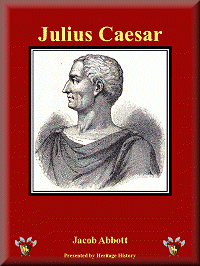 |
|
Cleopatra
This story of Cleopatra starts with a brief history of Egypt and the illustrious
Ptolemies. By the time Cleopatra came of age, her life was already full
of danger and intrigue, even before her romantic encounter with Julius
Caesar. Under the protection of Caesar she enjoyed a few years of security
on the throne of Egypt, but the death of Caesar led her to seek protection
from his successor, Mark Antony. Their tragic story is one of the most
dramatic liaisons in history.
Click here to
read as a webpage
|
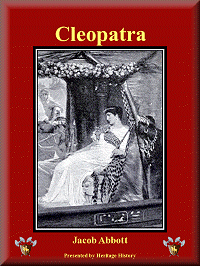 |
|
Nero
The story of Nero is also the story of much of the Julio-Claudian dynasty.
The bloody legacies of the previous emperors Caligula and Claudius are
introduced before delving into Nero's own reign of intrigue, murder, and
atrocities. The women of the family, including Nero's mother Agrippina,
his wife Poppaea, and the empress Messalina, contribute their share of
villany to the tale. The death of Nero provides a pathetic testimony to
the cowardice that often underlies tyranny.
Click here to
read as a webpage
|
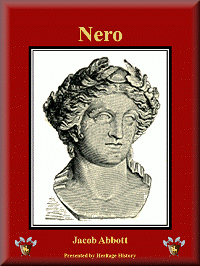 |
|
Alfred the Great
There are many examples of tyranny and depravity among English monarchs,
but few examples of courage and virtue that compare to the legacy of Alfred
the Great. Alfred was king of England during a time when the Saxons were
under assault from Danish sea-pirates who were destroying the fabric of
their civilization. But instead of allowing the Saxon civilization to be
destroyed, he unified it, strengthened it, and established churches and
centers of learning and culture.
Click here to
read as a webpage
|
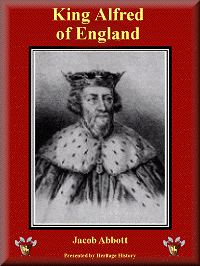 |
|
Richard I
This story of Richard I begins with his fascinating parents, Eleanor of
Aquitaine and Henry the II, founders of the Plantagenet line of English
kings. Once Richard ascends to the throne the story moves to the Holy Land,
scene of the second Crusade. When Richard arrived in Acre, he found that
vastly more energy was spent in posturing and infighting among the crusaders
than in actually fighting the Mohammedans, but through it all, he managed
to maintain a glamorous appearance of chivalry and apparent victory.
Click here to
read as a webpage
|
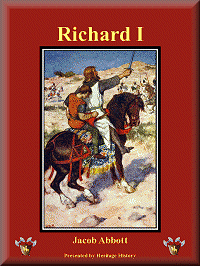 |
|
Richard II
The first several chapters of Richard II recap the turbulent reigns of
the previous Plantagenet kings including John Lackland and the three Edwards.
Several chapters are then dedicated to the Black Prince, Richard's father,
who achieved great fame at the battles of Crecy and Poitiers. The reign
of Richard II was most notable for the Wat Tyler rebellion and the fact
of that he was eventually deposed.
Click here to
read as a webpage
|
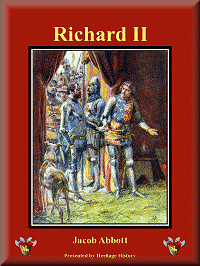 |
|
Richard III
The War of the Roses did not end with the death of Henry VI and the exile
of Queen Margaret. Although Edward IV eventually gained the throne, the
York family's struggles were not over. On Edward's death, Richard III usurped
the throne from Edward's sons. The book covers the reign of Edward IV,
the usurpation of Richard III, and the eventual triumph of Henry Tudor,
which brought the War of the Roses to a close.
Click here to
read as a webpage
|
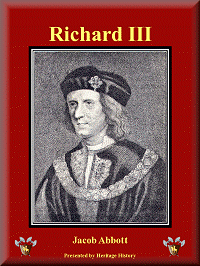 |
|
Margaret of Anjou
It is hard to understand why Margaret of Anjou, a central character of
the War of the Roses, is not more well-known. She was an intelligent, driven,
and fearless woman who essentially ruled England for her husband, Henry
VI, during his reign. This book covers the events leading up to the War
of the Roses and helps to untangle the confusing threads of that confrontation.
Click here to
read as a webpage
|
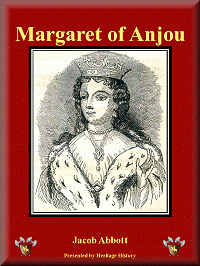 |
|
Queen Elizabeth
The life of Elizabeth encompassed the turbulent reigns of her brother Edward
VI and sister Mary as well as her own reign of nearly 45 years. She ascended
to the throne amid great controversy between Catholics and Protestants,
yet she successfully navigated through these treacherous times and achieved
a great deal of stability and prosperity for England. Her reign was populated
with very colorful characters including Drake, Raleigh, and the Earl of
Leicester. The Spanish Armada, which occurred late in her reign, was one
of the most important battles in history.
Click here to
read as a webpage |
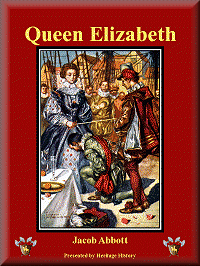 |
|
Mary Queen of Scots
Mary Queen of Scots was the arch-rival of Queen Elizabeth. As monarch of
Scotland, she too reigned over a kingdom that was torn by struggles between
Catholics and Protestants. However, while Elizabeth was able to maintain
power, Mary lost her throne and ultimately became Elizabeth's prisoner.
Mary was celebrated for her beauty and gentleness, yet it was precisely
her feminine appeal and unhappy marriages that caused her downfall.
Click here to
read as a webpage |
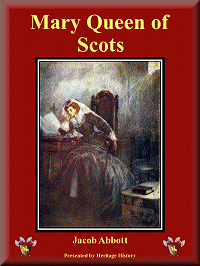 |
|
Charles I
Charles I had the misfortune to reign during a period when Parliament,
mainly representing the rising merchant class of England, had the temerity
to assert its growing power. His reckless youth was spent carousing with
the infamous Duke of Buckingham, and his mid-years were spent quarreling
with parliament. His misdeeds were no worse than many of his predecessors,
but he paid a much heavier price. After losing a civil war, he spent his
last few years in captivity and was the only English king ever executed.
Click here to
read as a webpage |
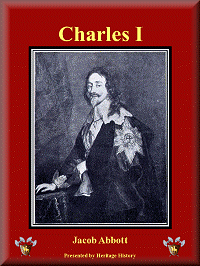 |
|
Charles II
Charles II's youth was spent in exile in France, while his father was kept
in captivity by Parliament. Though he nominally became King of England
at his father's death, he was prevented from assuming the throne until
the death of Cromwell. His story covers some highlights of the Commonwealth,
including his dramatic escape from Cromwell's army and complicated power
shuffling between Parliament, the army, and various Royalist factions.
Some lowlights of his actual reign include the Great Plague, the Fire of
London, and the Dutch invasion.
Click here to
read as a webpage |
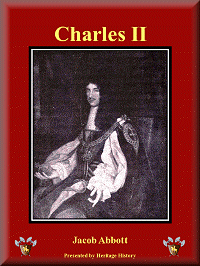 |
|
Peter the Great
By sheer force of will, Peter the Great single-handedly imposed modernization
on a highly resistant Russia. He overcame foes from within his country,
including his sister Sophia, whom the anti-modernist forces favored for
the throne. He overcame Charles XII of Sweden, his great rival for control
of the Baltic, in spite of overwhelming defeats. He considered his son
Alexis unworthy of the throne and had him killed rather than trust his
kingdom to a libertine.
Click here to
read as a webpage |
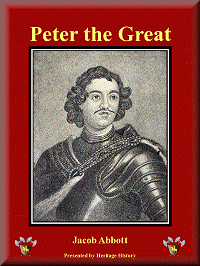 |
|
Genghis Khan
The story of Genghis Khan provides a fascinating picture of the nomadic
tribes of Asia. At its height, Khan's empire extended all the way from
China to Turkistan and was composed of hundreds of tribes of nomadic warriors.
No town, no matter how well fortified, was safe from his seemingly endless
horde of followers. No enemy that resisted him escaped his grasp.
Click here to
read as a webpage |
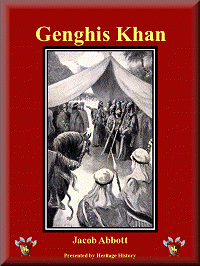 |
|
Hernando Cortez
Cortés was a Spanish Conquistador who led an expedition that caused
the fall of the Aztec Empire and brought large portions of mainland Mexico
under the rule of the King of Castile in the early 16th century. Cortés
was part of the generation of Spanish colonizers that began the first phase
of the Spanish colonization of the Americas.
Click here to
read as a webpage |
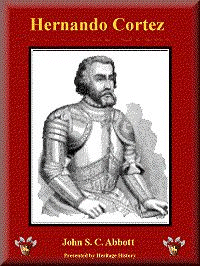 |
|
King Philip
King Philip was the leader of the Wampanoag Indians. His father had been
friendly to the early American colonists in New England. After a long period
of peace, he saw that as the colony thrived, his lands were ever diminished.
He realized the Indians were doomed unless they drove the white men from
their soil, and so turned against the settlers in what became the most
ferocious uprising of Indians in New England history
Click here to
read as a webpage |
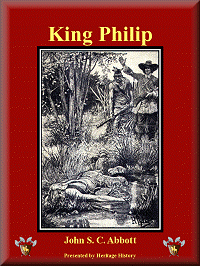 |
|
Henry IV
Henry IV came to the throne of France during a period of terrible religious
and political strife. The kingdom was in the throes of civil war between
Huguenots and Catholics, but the religious aspects of the conflict masked
even greater political divisions. Henry IV fought on the Protestant side,
but reconverted to Catholicism when he became king and spent much of his
reign helping to heal old wounds and mend relations. Through the life of
Henry IV, the story of the Protestant Reformation in France is told with
great insight.
Click here to
read as a webpage |
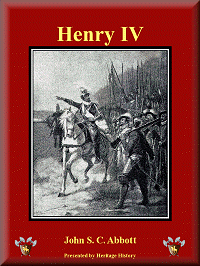 |
|
Louis XIV
Louis the XIV ruled France for over seventy years, during which time both
the power of France and the corruption of the aristocracy increased greatly.
This biography provides an overview of the wars and political events of
his reignn as well as insight into the palace politics and personalities
during this critical period in French history.
Click here to
read as a webpage |
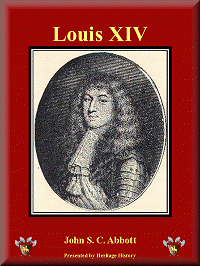 |
|
Hortense
Hortense de Beauharnais was the daughter of Josephine, the sister-in-law
of Napoleon and the mother of Napoleon III. Her life spanned the era from
the French Revolution throughout the Napoleonic Wars and the tumultous
years of the first French Republic, and provides insight into both the
political developments of the age, and the domestic relationships of the
extended Bonaparte family.
Click here to
read as a webpage |
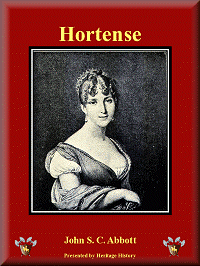 |
|
Madame Roland
Madame Roland was one of the most fasicinating characters of the French
Revolution. Born into relative poverty, Marie Roland was a brilliant intellectual
who married into a noble family. Her husband was a minister of the Revolutionary
government during the early years of the French Revolution, and she became
secretary and behind-the-scenes mastermind of the Girondist party. Although
the Girondists thoroughly supported the revolution, their criticism of
the outrages of some of the lawless revolutionaries earned them the emnity
of the increasingly radical Jacobin party, and Marie Roland died on the
scaffold during the reign of terror.
Click here to
read as a webpage |
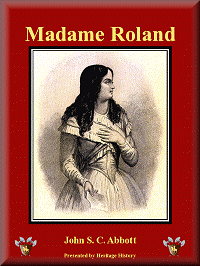 |
|
Joseph Bonaparte
Joseph Bonaparte was the oldest brother of Napoleon and one of his closest
advisors. He shared all of the best of Napoleon's republican ideals, but
lacked his brother's zeal and will to power. He was placed first on the
throne of Naples and later on the throne of Spain; in these positions he
governed justly but without the commanding resolve necessary to supress
rebellions and dissent from every quarter. Abbott's treatment of the Bonapartes
is highly sympathetic and includes much correspondence between the brothers
which gives enormous insight into the minds of both men.
Click here to
read as a webpage |
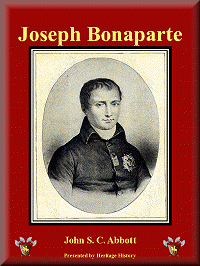 |
|
Josephine
Josephine was a French aristocrat who was widowed by the French Revolution,
but her fortunes turned once more when she married an ambitious young officer
in the Revolutionary army, Napoleon Bonaparte. The story of the rise of
Napoleon from obscurity to the emperor of the French and the master of
Europe is told with great insight from the point of view of his closest
advisor and confidant.
Click here to
read as a webpage |
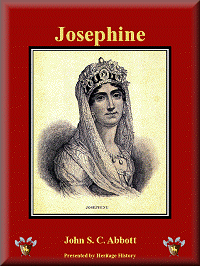 |
|
Louis Philippe
Louis Philippe was the son of the Duke of Orleans, the wealthy and liberal
aristocrat who joined his fortunes with the commoners during the French
Revolution only to lose his head during the Reign of Terror. His son spent
much of the next twenty years in exile and, after his cousin Charles X
was deposed during the Revolution of 1830, was crowned King of France.
Louis Philippe ruled as a liberal constitutional monarch and tried to help
modernize the country, but even he could not satisfy the republican ambitions
of the French radicals. He was deposed in 1848.
Click here to
read as a webpage |
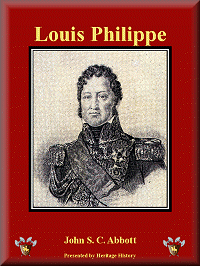 |
|
Maria Antoinette
Maria was an Archduchess of Austria from 1755 to 1770, a Dauphine of France
from 1770 to 1774 and the Queen of France and of Navarre from 1774 to 1792.
She was the fifteenth and penultimate child of Holy Roman Emperor Francis
I. and Empress Maria Theresa.
Click here to
read as a webpage |
 |
Back to main book index
|

































